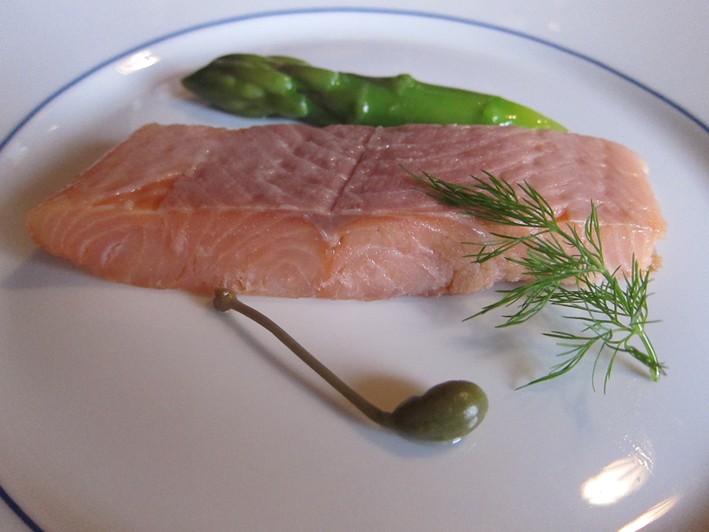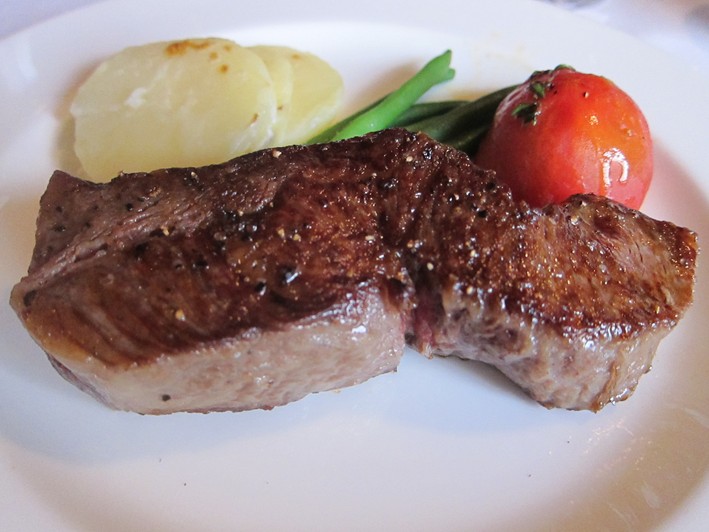In Japan beef is highly prized, and farmers and chefs take considerable efforts in its rearing and preparation. Wagyu just means “Japanese beef” (wa = Japanese gyu = beef) and in fact there are four breeds of cattle raised in Japan: black, brown, shorthorn and poll. Kobe is just one of many areas of Japan that raise the black wagyu cattle. Other famous examples (in Japan) are Matsuzaka, Omi and Yonezawa, but Kobe is by far the best known abroad. Kobe-style beef is often seen on menus in other countries described as Kobe beef, but this is just a loose term for the black wagyu cattle raised in a similar style in other countries such as the USA, Australia and Chile. These are not “true” Kobe beef, which is a registered trademark and has to meet several criteria, including being a bullock born and slaughtered in the Hyogo prefecture (which includes Kobe) and having a minimum marbling ratio and meat quality score in the Japanese beef grading system. The latter is an elaborate system classifying meat according to grade (scored 1-5, 5 being best) and marbling (scored 1-12, 12 being most marbled) based on seven separate measures (firmness, texture, colour, brightness, fat colour, lustre and quality).
Aragawa restaurant in Kobe is arguably the most famous Kobe beef restaurant in Japan. There is also a restaurant of the same name in Shinbashi, Tokyo, which is run by the uncle of the current head chef here. The Kobe Aragawa was founded in 1956, located in an exclusive and quiet area of the city. Aragawa’s founder chef was Jiro Yamada (who died in January 2011); he carved out an enviable reputation in a city that clearly knows its beef. Jiro’s first son, Mitsuya Yamada, has taken over as head chef. His second son is the restaurant manager.
The restaurant specialises in sirloin, using Sanda beef, the most premium form of Kobe beef, exclusively. Sanda beef production is tiny, with just 1,000 cattle annually, compared to 3,000 for all Kobe beef. The Aragawa dining room is quite conventionally decorated for a steak house, with exposed brick walls, carpet and tables covered in white linen. There is a short wine list with some prestigious wines. Weinbach Gewurtztraminer 2004 was ¥12,000 (£93) for a wine that costs £30 in a shop, Chateau Beycheville 2008 was ¥24,000 (£187) for a wine you can find in a shop for £65, and Opus One 2008 was priced at ¥40,000 (£312) compared to a retail price of £135.
An introductory nibble was a little tomato mousse with basil oil. The tomato flavour came across well but this was crying out for something to complement it: a little toast would have done nicely (13/20). Better was a slab of smoked salmon, the salmon being wild salmon caught in the waters off Hokkaido in the north of Japan. This was served with a spear of good Jaliyah asparagus. The salmon had plenty of flavour and was subtly smoked (16/20). Also good was a simple salad of tomato and fennel. The tomatoes had lovely flavour, the sort of flavour that you get in the Mediterranean, very different from the tasteless things that pass for tomatoes in the UK. The leaves and dressing was also good (16/20). Bread is made from scratch, white bread using a natural yeast, and had light texture and a good crust (16/20).
Pompano was cooked on a charcoal grill, the fish carefully cooked and having an enjoyable smoky flavour note from the grill (15/20). Of course the highlight was the beef, in this case sirloin. The restaurant uses ten different small farms to source its sanda beef, getting around four carcasses per month. This represents around 5% of the total production of sanda beef. This particular beef is not aged for very long, just three weeks, but has considerable inherent marbling. They deliberately use beef that does not have extreme marbling, which I personally agree with: some Kobe beef I have eaten is so marbled and buttery that it is easy to forget you are eating beef, but the sirloin here was just an ultra tender, regular steak, cooked on a charcoal grill. This was served simply with a cooked tomato, some beans and potatoes. It is difficult to score something like this, essentially just a steak, but made from arguably the best beef in the world (19/20, since the accompaniments could have been better, but this is certainly exactly what one would hope for from the beef).
Desserts comprised a choice of cheesecake, creme caramel and strawberry tart. These were nicely made, the creme caramel flavored with Grand Marnier, and the strawberries having plenty of flavour (15/20). Espresso coffee was also good (15/20). Service was very friendly and our waiter, who is also the restaurant sommelier, spoke good English. The bill came to ¥45,100 (£342) for two, including a single glass of wine, i.e. £171 a head. The steak meal was priced at ¥25,000, the fish meal at ¥12,000. This is a restaurant that is very much about the centerpiece sanda beef, although there was certainly care in the ancillary dishes, such as the home-made bread, the wild smoked salmon and the excellent tomatoes.


























jeffrey
I went here 10 years ago and to the one in Tokyo 10 days ago and was overwhelmed by the beauty of the beef. Totally decadent both times - A bucket list experience.